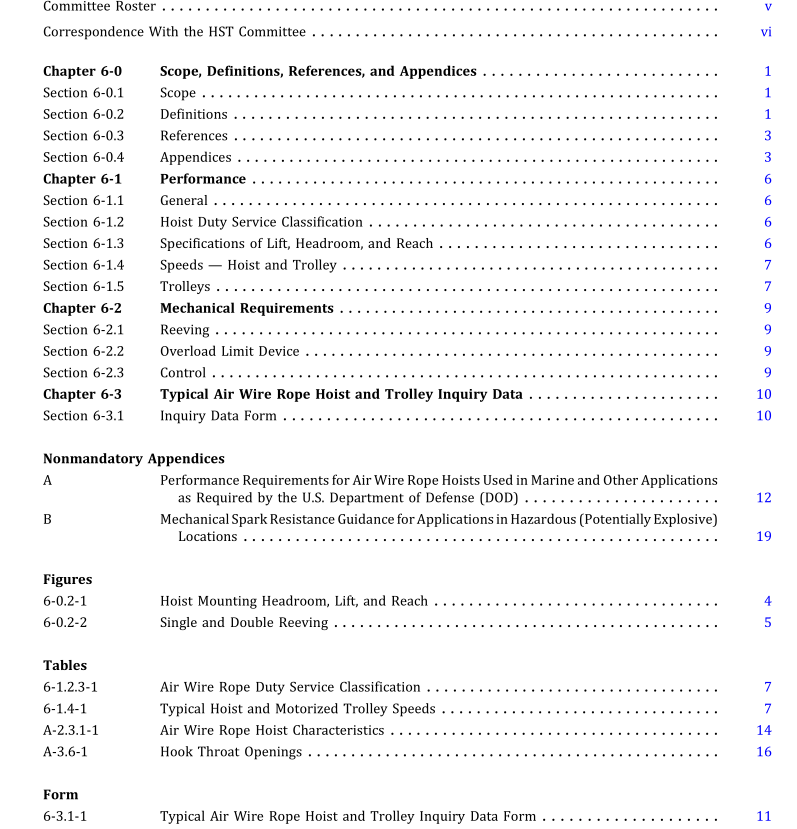ASME HST-6:2020 pdf download Performance Standard for Air Wire Rope Hoists
SECTION 6-1.1:GENERAL
All equipment selectedin accordance with this Standardis designed to perform satisfactorily when installed, inspected,tested,operated, and maintained in accordance with ASMEB30.16, Chapters 16-2through 16-4, and used within the ratedload and hoist duty service classification.All equipment shall provide speeds,lifts, and headroom in accordance with themanufacturer’s specifications or specifications agreed upon by the manufacturer and user.
SECTION 6-1.2: HOIST DUTY SERVICE CLASSIFICATION
6-1.2.1 General Considerations
Service conditions have an important influence on the performance of wearing parts of a hoist, such as gears, bearings,rope, sheaves, brake linings, load and lift limit devices, wheels,and pneumatic components. Careful consideration of thehoist duty service classifications described in this Section will enable the user to evaluate the application and obtain ahoist designed for optimum performance and minimum maintenance.If doubt exists regarding hoist selection,the hoistsupplier should be consulted.Many factors enter into the selection of the proper hoist to perform a given function.Hoisting equipment consists of both mechanical and pneumatic components, and both must be considered whenanalyzing the service the hoist must perform.
The factors that influence the performance of any hoist include the following:
(a〕 Load Distribution. Loaddistribution is the actual distribution orproportion of fulland partial loads to be handled bythe equipment, including lifting devices, and has an important effect on the life of power transmission components.Forexample,ball bearing life varies according to the cube of the load.A 2-ton(1814.4-kg)hoist operated at a mean effectiveload of 1 ton (907.2 kg) will have a ball bearing life of 8 times that of the same hoist used steadily at its rated load.(b 0perational Time. Operational time is the total running time of the hoist per hour or per work period.
(c Repetitive Long Lowering 0perations. Such operations generate heat in control braking means.
(d) Environmental Conditions. Examples include high or low ambient temperatures, dust, moisture, and corrosivefumes.
6-1.2.2 Hazardous Locations
When hoists are used in hazardous locations as defined byNFPA70 or other special codes,modifications or additionalprecautions notcovered bythis Standard may be required.In these locations, only hoists designed in a manner suitable forthe conditions encountered shall be used.Nonmandatory Appendix B provides guidance for both the manufacturer andend user to assist in configuring a hoist to make it suitable for use in a potentially explosive environment.
6-1.2.3 Duty Classification
While all the factors listed in para.6-1.2.1 must be considered in selecting the proper class of hoist, most industrialapplications can begeneralized according to the percentage ofrated load normally handled and the running time.Listed inTable 6-1.2.3-1 are the two duty classes that have been established for air wire rope hoists. The majority of hoist applica-tions fall into the A4 category.
sECTION 6-1.3: SPECIFICATIONS OF LIFT,HEADROOM,AND REACH6-1.3.1 Lift
Lift should be specified for the application.
6-1.3.2 Headroom
Headroom should be specified if important to the application.
6-1.3.3 Reach
Reach should be specified if important to the application.SECTION 6-1.4: SPEEDS – HOIST AND TROLLEY
Hoisting equipment is available over a wide range of hoist and trolley speeds.Table 6-1.4-1 lists typical speed ranges.NOTE:Table 6-1.4-1 is to be used as a guide only and is not intended to restrict either the manufacturer or the buyer from offering orspecifying speeds outside the ranges shown; nor should it be inferred that speeds above or belowthe ranges shown are notcompatiblewith the required class of hoist.
SECTION 6-1.5: TROLLEYS
Hoist trolleys are available in plain,hand-chain-operated, and motor-driven types.Selection ofeach type depends uponthe application.
When a trolley is required for use with a hoist,the type and size of support beam shall be specified to ensure that thetrolley is suitable for the minimum radius and the contour of the beam.
6-1.5.1 Plain-Type Trolleys
Aplain-type trolley is recommended where trolley motion is infrequent or relatively short.Due to the force required tomanually operate this type of trolley, it is also recommended that the use of plain trolleys be limited to a maximum load of3 tons (2727 kg), with the elevation of the beam not more than 20 ft (6 m) above the operator’s floor level.
ASME HST-6:2020 pdf download
